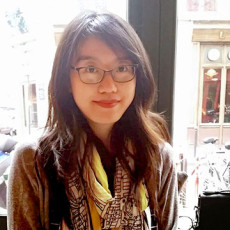This month, Helen Xu begins her role as Berkeley Lab’s new Grace Hopper Fellow. Established in 2015, this prestigious fellowship aims to develop young computer and computational scientists to make outstanding contributions to high-performance computing (HPC) applications.
Xu says she’s excited to bridge the gap between computer science and scientific applications in her new role. “One of the exciting things about being a computer scientist at Berkeley Lab is that you are working alongside people who need help optimizing their scientific applications, and I get to bridge that gap between computer science and scientific discovery,” she said. “Data structures underlie everything in computer science. If you’re developing an application, you have a bunch of elements you need to store; I work on effectively storing those elements so that you can compute on them quickly.”
Xu notes that her work so far has been focused on building data structures for applications running on traditional single-node computers, so she’s excited to learn more about optimizing scientific codes to run on non-traditional heterogeneous supercomputers like NERSC’s Perlmutter system, which is comprised of CPUs and GPUs.
Although Xu’s Hopper Fellowship just began this month, she’s been working in the Lab’s Performance and Algorithms Research Group since February 2022, joining shortly after receiving her Ph.D. in Computer Science from the Massachusetts Institute of Technology (MIT).
She notes that her passion for computer science ignited when she was an undergraduate student at Stony Brook University.
“In high school, I was really into debating, theater, and music. It wasn’t until I got to college that I thought I’d try computer science. One of my first projects was to create an efficient version of a data structure called a skip list, a probabilistic data structure built on the idea of a linked list, and it was just so elegant,” said Xu. “I fell in love with computer science.”
She spent the next four years working with her advisor Professor Michael Bender on theoretical data structures for sparse graphs. When she got to MIT, her advisor, Professor Charles Leiserson, encouraged her to explore both the theory and the application and implementation of data structures.
“I took his course, and it was a steep learning curve. I spent most of my undergraduate years working on theory and doing a lot of math, but after this course, I became interested in applying data structures—how you make these things work in practice,” said Xu. She credits this course with sparking her interest in research opportunities at the national laboratories. Before coming to Berkeley Lab, Xu also spent some time interning at Sandia National Laboratory in Livermore, California.
A native of New York, Xu notes that she’s looking forward to the relatively warm winters on the West Coast. An avid hiker, she’s also excited to explore hiking trails around the Bay Area.
About Berkeley Lab
Founded in 1931 on the belief that the biggest scientific challenges are best addressed by teams, Lawrence Berkeley National Laboratory and its scientists have been recognized with 16 Nobel Prizes. Today, Berkeley Lab researchers develop sustainable energy and environmental solutions, create useful new materials, advance the frontiers of computing, and probe the mysteries of life, matter, and the universe. Scientists from around the world rely on the Lab’s facilities for their own discovery science. Berkeley Lab is a multiprogram national laboratory, managed by the University of California for the U.S. Department of Energy’s Office of Science.
DOE’s Office of Science is the single largest supporter of basic research in the physical sciences in the United States, and is working to address some of the most pressing challenges of our time. For more information, please visit energy.gov/science.










